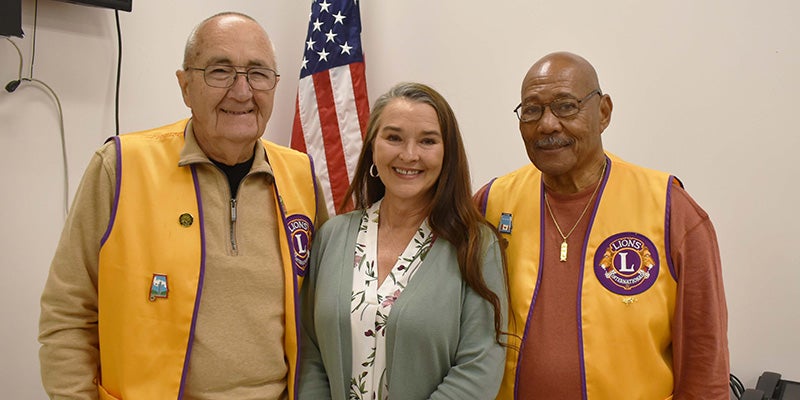Chambers County E-911: Fast response times and safety
Published 10:30 am Tuesday, April 25, 2023
|
Getting your Trinity Audio player ready...
|
HUGULEY — Kathy Hornsby, the deputy director of Chambers County E-911, was the guest speaker at this week’s meeting of the Valley Lions Club. The meeting took place inside the E-911 center, and Hornsby reviewed what an emergency manager does, and what takes place inside the center every day.
Chambers County E-911 is best known for what it does during stormy weather, but there’s a lot emergency management has to be prepared for that most people are not aware of. One such scenario involves earthquakes. “We have had two of them since we have been in this building,” Hornsby said.”I felt both of them,”
While both were relatively minor tremors, there is a fault line that affects this area and emergency officials must be prepared in the event there’s ever a bigger one.
A bad earthquake is a rare event in this part of the country but they do happen from time to time. “Everything that’s underground could be badly damaged,” Hornsby said.”We have to know what to do should that ever happen. The state and FEMA is prepared to assist us in any event where we would need help.”
Hornsby said she was hopeful of getting an emergency declaration for a recent flooding problem in the county and the current water problem in LaFayette.
“The county and the cities have had to spend money due to recent weather-related problems,” she said.
When a given county has been impacted by a storm, damage assessments have to be made. Such information is used to track weather trends. “Meteorologists have told us that weather is hard to predict in this part of the country,” Hornsby said. “We have weather coming in off of the gulf and the jet stream bringing in weather systems from the north.”
Most disasters are in some way weather related. “Every disaster presents something different,” Hornsby said. “It’s a team effort between Chambers County EMA, E-911 and first responders in getting things back to normal.”
Hornsby and EMA Director Jessica Yeager make trips to local schools and talk to school children about what they do. “It helps their fears of the unknown subside when they know how prepared our county is if bad weather comes our way,” Hornsby said.
Chambers County is fortunate, said Hornsby, to have an E-911 communications supervisor with the experience of Darlene Billingsley. “She makes sure all ALEA calls are being followed,” she said.
There are some major differences between old 911 and the current E-911. Old 911 was basically a land line-based system. With the widespread use of cell phones today, that way of doing things has given way to a newer system which can better track cell phone locations.
“E-911 stands for enhanced 9-1-1,” Hornsby said. “Enhanced means that the call system automatically reports the telephone number and location of 9-1-1 calls. E-911 ties a location to the call, whether it be a specific address or coordinates. If we had to explain enhanced 911, or E-911, in five words or less we would tell you that it’s location services for 911 calls.”
The enhanced location features of E-911 service allows for rapid response times during an emergency. This can be critical in responding to places where there are a lot of people gathered such as schools, work places, and shopping areas.
“Our 911 operators are dispatchers, but I prefer to call them communications officers,” Hornsby said. “That’s what they are. They are professionals who have been through many hours of training to learn how to gather critical information and to prioritize calls for service while keeping callers calm and safe.”
Yeager and Hornsby work together to make sure the communications officers have the tools they need to perform their jobs efficiently and effectively. They make sure the equipment is operating properly and that all computers and electronics are up to date. They also make sure their seats are comfortable. “They spend so much of their time in that seat and many times are in high stress situations,” Hornsby said.
Chambers County EMA and E-911 gets its information from FEMA and AEMA (the federal and state emergency management agencies). the National Weather Service and especially the Birmingham office of the NWS, and other reliable sources like James Spann, Columbus TV meteorologists, healthcare organizations, the Chambers County Commission, local leaders and first responders.
Hornsby sends out over 300 emails to many different sources in the event of storm systems being on the way.
Hornsby has been with the county’s EMA/E-911 systems for more than 20 years. She has seen the organization grow from everything being on pen and pencil to going digital, from going from handheld CB radios to digital computer voice over radio, from analog phones to digital phones and voice over internet (VOIP) protocol. “We can even receive texts and respond to them,” she said. “We have redundancy in everything from servers to radios and phones and power, or other critical services,” she said.
“We have better collaboration between federal, state and local partners,” Hornsby said. “We have a whole community approach to mitigation, prevention, preparedness, response and recovery. We often gather after disasters and collaborate on what went well, what didn’t and why, and how we can do better. Bringing the lessons together from disasters that have happened all over the state helps us improve our plans and prepare for a better tomorrow.”
In the days of old 911, if a caller couldn’t get through for some reason, they were left out on a limb. “It’s better now,” Hornsby said. “We have faster response times. It also helps to have well trained communications officers who have been doing what they do for a long time. Communication between agencies is much better than it used to be. Being better prepared makes for a safer county.”






